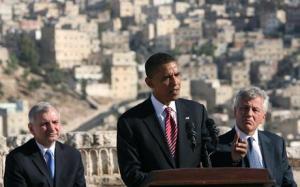
This news was picked up by the Palestinian media, in particular the PNN and Maan agencies. Thus, according to sources of Gal-On, this topic was discussed behind closed doors during a recent meeting of Israeli Prime Minister Benjamin Netanyahu and U.S. Secretary of State John Kerry in Rome. Radical leftist Israeli politician also said that in January 2014, the Obama Administration intended to achieve a “real diplomatic breakthrough”: the Americans want to move from policy of coordination between the two parties to the phase of active intervention.
It was reported that the administration of the U.S. President intended to present a new diplomatic plan, in which the solutions of major problems together would be proposed on the basis of 1967 borders and territorial exchange. The plan is also going to include a timetable for its implementation. The plan is going to deal with the problem of regional peace and the Arab Peace Initiative. It will also include the economic programme providing large investments into the Palestinian economy.
The existence of the U.S. Administration’s plan was reported by the Israeli radio station Galei Tzahal, citing its own sources. It was noted that Washington would begin implementation of this plan, if before January, a peace agreement between Palestinians and Israelis cannot be achieved and clearly formulated.
According to Haaretz and Galei Tzahal, the Americans made the basis of their plan the “Saudi peace initiative” and “Clinton’s parameters” formulated by U.S. President Bill Clinton back in December 2000, during negotiations with then Israeli Prime Minister Ehud Barak and Palestinian leader Yasser Arafat at Taba. These “parameters” include return of Israel to its 1967 borders, the division of Jerusalem and the introduction of a special status in the Old Town, the evacuation of all Jewish settlements on the West Bank of Jordan (or, as these occupied territories are called in the Israeli political discourse, “Judea and Samaria”), as well as the transfer of part of the border with Jordan under the control of the Palestinian Authorities. The “Saudi Initiative” made provisions for the gradual settlement of the Arab-Israeli conflict in the case of implementation of the plan as a whole.
At the sessions of the Israeli government, Netanyahu repeatedly voiced quite a vague formula of the peace agreement. He stated: “In order for the peace to be achieved between us and our neighbours, the Palestinians, they must recognize the right of Jews to having a state in our country. This means that they must recognize a permanent agreement, while withdrawing all claims on a national basis, against the State of Israel. The second is the principle of security – a principle that will keep the peace and protect the State of Israel if a peace agreement is violated. Security arrangements are fundamental to us, and we insist on them. These agreements will contain many components, but the main point for us is that Israel’s security border will be established along the Jordan River.”
However, Netanyahu has repeatedly stressed that he and U.S. Secretary of State also rejected the idea of retreat to the 1967 borders, and the division of Jerusalem, which, as was known, was proclaimed by the Israeli authorities as the “eternal and undivided capital of the Jewish state”. In November of this year, meetings were held between the U.S. Secretary of State with Netanyahu and Chairman of the National Palestinian Autonomous Territories Mahmoud Abbas, where all these questions were actively discussed. And the Executive Office of Netanyahu has not made any comments on the rumours about the presence of an “American plan” for settlement of the Palestinian-Israeli conflict yet.
Obama’s January plan (if the U.S. really puts it on the negotiating table) looks attractive, but only on paper. As soon as it comes into contact with the political realities, this plan is unlikely to be achievable, at least until the Israeli government fundamentally changes its position on the main points of peace with the Palestinians. And this will happen ad calendas graeces (when hell freezes over).
Alexander Efimov, PhD of Historical Sciences, an expert on Middle East problems, exclusively for the online magazine “New Eastern Outlook” .
